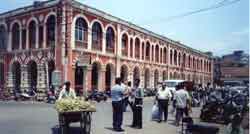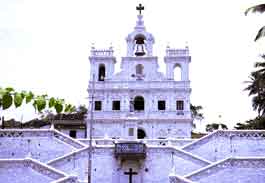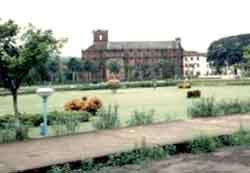| Destinations
|
||
Ancient 2000 BC - 1500 AD
The earliest settlement in Goa was around 2200 BC in Sumerian times, when King Gudea of Lagash called it Gubio. Sumerians portioned the fields of Goa to follow their measure of 12 cubits to a pole, and 0.495 of a metre to a cubit unlike the 0.46 unit generally prevalent. Later the sea borne community of Phoenicians became the first extensive settlers of Goa around 1775 BC. Vedic Periodic 1000 - 500 BC According to legend as described in the Skanda Purana: Vishnu, in his avatar as Parsurama shot an arrow to mark the limit where Samudra the Indian Neptune should withdraw. Defeated, Samudra receded many miles of its aquatic reign. The arrow fell in Bannali (Bann: arrow, ali: village) and this is how the village of Benaulim got its name. |
More on Goa • Overview • Geography • Economy • Festivals • Wildlife • Towns • Getting Around • Climate • North Goa Beaches • South Goa Beaches • Wildlife Impressions • An Introduction • Barracuda |
|
Aryan Conquest 200 BC
Strabo the Greek geographer during the reign of the Roman Emperor Augustus (27 BC -14 AD) made the first reference to Konkan then named KomKvi. Old Arab geographers, referred to Goa as Sindabur. Al-Masudi (AD943) an Arab voyager, considered Sindabur as the foremost of the coastal cities of Malabar. After the Mauryan Empire (321 BC to 185 BC) various dynasties of diverse origins, fought over the control of Goa. The Chalukyas , Hoysalas and Kadambas reigned from 937 AD to 1346 AD. After the Kadambas, Goa was ruled by the Yadavas of Devaguiri (modern Daulatabad) from the 12th to 13th century AD, the hindu empire of Vijayanagar (14-15th century AD), and became a part of the Muslim Bahmani Kingdom of Deccan in the 15th century. This resulted in the destruction of many hindu temples and was a foretaste of things to come under Portuguese rule. In 1492, the Bahmani Kingdom split into five kingdoms, namely Bidar, Berar, Ahmadnagar, Golconda and Bijapur. Bijapur was the capital of the territory which included Goa under Adil Khan who established a thriving new port further north at the head of the Mandovi river. The Portuguese conquest of Goa
Decline of Portuguese Power The Portuguese faced very few threats from outside from the late 17th century onwards. However, they had to deal with dissatisfaction from within. The first revolt, also known as the Pinto Revolt broke out in 1787. The leaders of the plot were some prominent priests of Goa who had the support of some military officers of Goan origin. It was a planned revolt to overthrow the Portuguese regime. After several executions and deportations, this revolt was crushed. The capture of Satari proved to be the source of continued trouble for the Portuguese. The "Ranes" who occupied much of Satari were in a state of constant revolt for almost 150 years. It was only until 1912 that they were finally subdued.
One consequence of the British presence in Goa was the beginning of Goan emigration to Bombay, Poona, Karachi, Calcutta and various other parts of British India. The opening in 1878 of the port of Marmagoa to traffic with India, as well as the establishment of rail links in 1881 with India served to lessen Goa's isolation. In 1900, Luis Menezes Braganza founded the first Goan Portuguese-language newspaper, the "O Heraldo", where he criticized Portuguese colonialism in Goa. With the ascension of the Salazar regime in Portugal in 1926, there was suppression of Goan and Portuguese civil liberties. In 1928, Dr. Cunha founded the Goa National Congress, which was linked with the Indian National Congress which was at the time fighting the British to reclaim Indian Independence. Many of the Christian Portuguese-speaking Goans, though disliking the Salazar regime, looked with trepidation at the possibility of merging with India. Mahatma Gandhi's movement for Indian independence, intensified in the thirties. The suppression of liberties in Goa and the intolerable conditions created by the dictatorship brought the great Indian socialist leader, Dr. Ram Manohar Lohia to Goa. At a public meeting at Margao, he launched a movement for civil liberties which set in motion a mass movement for freedom from Portuguese rule. This can be termed as the beginning of the last phase of the freedom struggle of Goa. The satyagraha movement continued up to November 1946 during which a number of leaders were arrested for defying the ban on civil liberties. However by the end of 1946 a general political depression followed. At the same time, the Portuguese government adopted more and more repressive measures to root out the movement from Goa.
The Portuguese Government, in the meantime, had brought in both white and African troops and increasing quantities of war material that created a sense of fear in the population. The success of the post-Independence Goan struggle for freedom from Portugal owed as much to the efforts of the Indian government, who cut off diplomatic ties with Portugal, as to the work of freedom fighters such as Menezes Braganza and Dr Cunha. After a "liberation march" in 1955 resulted in a number of deaths, the state was blockaded. Trade with Bombay ceased, and the railway link was cut off. In 1961, India's Prime Minister Jawaharlal Nehru, after his failure to have an amicable settlement with Portugal's Premier Dr. Antonio de Salazar, launched "Operation Vijay" in defiance of a United Nations resolution. It met with only token resistance, and the Indian army overran Goa in two days. Thereafter, Goa, along with Portugal's other two enclaves, Daman and Diu, became part of India as a self-governing Union Territory, with minimum interference from Delhi. Since then, Goa has continued to prosper, bolstered by receipts from iron-ore exports and a booming tourist industry, but it is struggling to hold its own against a tidal wave of immigration from other Indian states. Its inhabitants voted overwhelmingly to resist merger with neighbouring Maharashtra in the 1980s, and successfully lobbied for Konkani to be granted official-language status in 1987, when Goa was finally declared a fully-fledged state of the Indian Union.
|
||
Editor: Romola Butalia (c) India Travelogue. All rights reserved. |
||

 The Aryans pushed the Dravidian kingdoms such as the Cholas, Pandyas, Tamil Mad, Satyaputras and Keralaputras. to the southern tip of India. Goa became the southern fringe of the empire of Ashoka around 200 BC.
The Aryans pushed the Dravidian kingdoms such as the Cholas, Pandyas, Tamil Mad, Satyaputras and Keralaputras. to the southern tip of India. Goa became the southern fringe of the empire of Ashoka around 200 BC.
 The Portuguese were initially quite tolerant of the Hindu religion although not as tolerant of Muslims. 1540 onwards, under the influence of the Counter Revolution in Europe, Portugal's liberal policy towards the Hindus was reversed. Many Hindu temples were razed and churches built on them; while the few Muslims there dispersed. The characteristic Portuguese names that many Christian Goans have today, is to a very small extent due to inter-marriage between the Portuguese and local Indians. Rather, the converts, were forced to adopt a Portuguese name, usually that of the priest responsible for their conversion.
The Portuguese were initially quite tolerant of the Hindu religion although not as tolerant of Muslims. 1540 onwards, under the influence of the Counter Revolution in Europe, Portugal's liberal policy towards the Hindus was reversed. Many Hindu temples were razed and churches built on them; while the few Muslims there dispersed. The characteristic Portuguese names that many Christian Goans have today, is to a very small extent due to inter-marriage between the Portuguese and local Indians. Rather, the converts, were forced to adopt a Portuguese name, usually that of the priest responsible for their conversion.
 In 1835, a Goan, Bernardo Peres da Silva, was appointed Prefect by the King of Portugal. The European elements did not like the appointment and he was compelled to relinquish his post. He took refuge in India but did not get disheartened. He organised an expedition assisted by British authorities who even provided him naval and military personnel. The expedition ended in failure.
In 1835, a Goan, Bernardo Peres da Silva, was appointed Prefect by the King of Portugal. The European elements did not like the appointment and he was compelled to relinquish his post. He took refuge in India but did not get disheartened. He organised an expedition assisted by British authorities who even provided him naval and military personnel. The expedition ended in failure.
 Life having become difficult in Goa for the anti-Portuguese and freedom lovers, the scene of operations to oust the foreigner had perforce to be shifted to across the frontiers into India which was about to earn its long fought freedom from Britain. The National Congress (Goa) which was already functioning in Goa began its operations in Bombay; the other parties formed were the Azad Gomantak Dal, the United Front of Goans, the Goa Liberation Council, the Goan People's Party, the Quit Goa Organisation, etc. The National Congress as well as the Liberation Council believed in non-violence while the Azad Gomantak Dal set out to obtain weapons and, infiltrating into Goa, began to attack the Portuguese troops and harass the Portuguese in every way.
Life having become difficult in Goa for the anti-Portuguese and freedom lovers, the scene of operations to oust the foreigner had perforce to be shifted to across the frontiers into India which was about to earn its long fought freedom from Britain. The National Congress (Goa) which was already functioning in Goa began its operations in Bombay; the other parties formed were the Azad Gomantak Dal, the United Front of Goans, the Goa Liberation Council, the Goan People's Party, the Quit Goa Organisation, etc. The National Congress as well as the Liberation Council believed in non-violence while the Azad Gomantak Dal set out to obtain weapons and, infiltrating into Goa, began to attack the Portuguese troops and harass the Portuguese in every way.